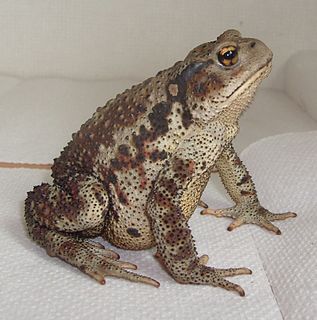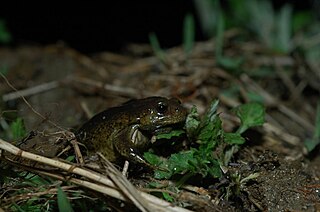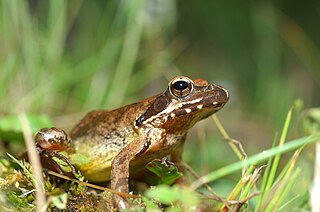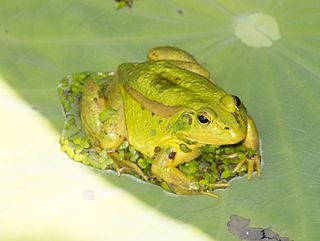 W
WThis is a list of amphibian species found in the wild in Korea, including the Korean Peninsula and Jeju Island. A total of 20 species of amphibians are known from Korea; this includes two species of salamander that were not discovered until the 21st century.
 W
WThe Asiatic toad or Chusan Island toad is a species of toad endemic to East Asia. It is common in China and portions of the Russian Far East, but relatively rare on the Korean Peninsula. Asiatic toads are also found on the Miyako Islands of southern Japan, although they have been extirpated from some islands in recent years, possibly including Okinawa. The Miyako subspecies, Bufo gargarizans miyakonis, is also known as the Miyako toad.
 W
WThe boreal digging frog is a species of microhylid, or "narrow-mouthed," frog found in Northeast Asia. Its range covers much of central and northeastern China, the Korean Peninsula, and Jeju Island. Adult boreal digging frogs are roughly 4.5 cm in length, round in shape with toad-like speckled skin. Tadpoles are up to 35 mm (1.4 in) in length.
 W
WDryophytes flaviventris, also known as the yellow-bellied tree frog, is a species of Ameroasian tree frog native to the central lowlands of the Republic of Korea, where it is known to occur in Buyeo, Nonsan and Iksan. It was described in 2020 after research showed it to have genetic and morphological differences compared to Dryophytes immaculatus and D. suweonensis. The yellow-bellied tree frog is geographically separated from D. suweonensis by the Chilgap mountain range, and from other Dryophytes species by the Yellow Sea. The yellow bellied tree frog is estimated to have split off from D. suweonensis approximately 0.97 million years ago.
 W
WDybowski's frog is a species of true frog found in Northeast Asia. It is found in the Russian Far East, the Korean Peninsula, and the Japanese island of Tsushima. It may also exist in northeastern China, but this has not been confirmed.
 W
WHynobius quelpaertensis, the Jeju salamander, also spelled Cheju salamander, is a species of salamander found on various islands and peninsulas off the southwestern coast of the Korean Peninsula, including Jindo, Geojedo, Jejudo, and Namhae. It inhabits moist mountain forests.
 W
WThe Japanese tree frog is a species of tree frog distributed from Hokkaidō to Yakushima in Japan and from Korea along the Ussuri River to north-eastern China, northern Mongolia, and the southern parts of the Russian Far East.
 W
WThe Korean brown frog is a species of frog in the genus Rana. It is native to the Korean Peninsula and Shandong, China.
 W
WThe Korean salamander is the most common species of salamander on the Korean peninsula, and is also found in nearby provinces of China and on Jeju Island. It typically lives on forested hills, and from time to time mass deaths occur in Korea when salamanders encounter man-made drainage structures. This has prompted Korean government officials to execute a series of mass evacuations in heavily salamandered areas.
 W
WThe Mongolian toad, also known commonly as the piebald toad or the Siberian sand toad, is a species of toad in the family Bufonidae. The species is endemic to northeastern Asia. It was formerly placed in the genus Bufo, then for a few years in Pseudepidalea until finally moved to its own genus Strauchbufo.
 W
WOnychodactylus fischeri is a lungless salamander found in Northeast Asia. It ranges through northeastern China, the Russian Far East, and the Korean Peninsula, but is only sporadically distributed within this range. Within South Korea, it is found chiefly in the high mountain valleys of Gangwon province, including the Gwangdeoksan and Daeseongsan regions. The adults feed on spiders, grubs, and insects. Common names include Fischer's clawed salamander and long-tailed clawed salamander.
 W
WThe Oriental fire-bellied toad is a small semiaquatic frog species found in Korea, northeastern China, and adjacent parts of Russia. An introduced population exists near Beijing. They are commonly kept as pets in land and water vivaria. B. orientalis is also known as the 'tuti toad'.
 W
WPelophylax nigromaculatus, is a species of true frog found in East Asia, first described in 1861. This widespread and common frog has many common names, including dark-spotted frog, black-spotted pond frog, and black-spotted frog.
 W
WRana amurensis is a species of true frog found in northern Asia. It ranges across western Siberia, as well as northeastern China, northeastern Mongolia, and on the northern Korean Peninsula and on Sakhalin. Rana coreana was previously included in this species as a subspecies. Found at latitudes up to 71° N, it is the northernmost wild amphibian species.
 W
WSalamandrella keyserlingii, the Siberian salamander, is a species of salamander found in Northeast Asia. It lives in wet woods and riparian groves.
 W
WThe Seoul frog or Seoul pond frog is a species of true frog found on the southern and western Korean Peninsula, and possibly across the border to China in Liaoning. It is closely related to the eastern golden frog, P. plancyi, and was long considered a subspecies thereof. Also known as gold-spotted pond frog, it is in fact not a true pond frog of genus Rana, but belongs to the water frogs now again separated in Pelophylax.